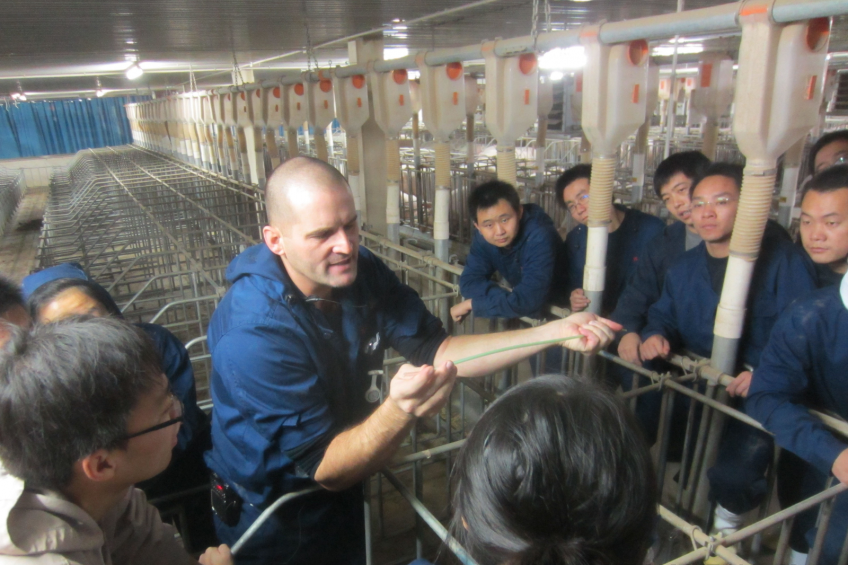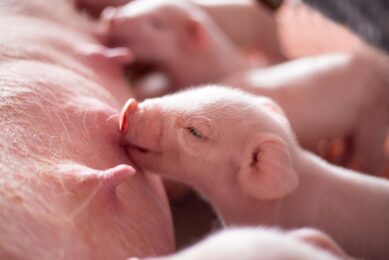Top 5 breeding challenges in China

Producing pigs in China can be a challenge for even the best producers. The challenges related to pig production are endless starting with health issues, management issues, feed quality and much more. Which are the 5 that jump out?

Turnover of staff
Most pig producers in China have a problem with turnover of farm staff. At some of the farms we visited, the turnover can hit 100% per year. As the development from backyard to large scale commercial farms is occurring, producers are afraid of contamination of new diseases. Therefore, the new large scale farms are built with a dormitory where the staff live for a shorter or longer time without being able to leave the farm area. This means that the farm technician or herdsman is away from his or her family and social life while working on the farm.
Farm staff consists of a mix of highly educated people with a bachelor’s, master’s and even PhD degree while the rest is uneducated or have very limited education. The highly educated staff have ambitions and do not want to live on a farm for a long period of time but use maybe a six-month stay as a jumping board to a better job.
By having a large turnover of staff, the farm is always in training mode, where the best staff is busy training new staff instead of working with the animals which he/she is best at.
So how to deal with the turnover on farms, this is a big challenge. Some pig farm companies have acknowledged the problem and seek solutions on how to solve the problem.
One solution for companies is to develop their own internal training programme suited to their need and situation. It is not just training and education of staff that is being implemented, farms and pig producing companies are creating environments where the staff can bring their families. Another solution is to have the staff work three weeks and have one week off every month.
There is currently no perfect model for reducing staff turnover but companies know they need to address the issue before it is too late.

Feeding strategy and water availability
A large number of farms that are visited have a strategy of not feeding sows on the day of weaning. The theory behind this is that the sow will wean herself quicker if she is not fed feed.
After weaning many farms also limit the feed until oestrus occurs, resulting in a prolonged wean-to-oestrus interval. This results in increased non-productive days (NPD) and a lower efficiency of the farm. Water availability for sows is another problem checked at many farms. Low availability of water during breeding and early stages of gestation interfere negatively in reproductive parameters. Results from urinalysis performed at different farms during last year in China showed significant prevalence of sows with high density urine, a condition associated with low daily consumption of water.
At Carthage MHJ Agritech Consulting, the experience is that some farms starve sows on wean day but also decrease the feed amount daily from day 4 prior to weaning. This strategy also leads to an increased wean-to-oestrus interval as well as lower litter size in the next litter and increased NPD in the herd. It is recommended to feed at sows full feed or according to appetite (depending on genetics) all the way through to breeding. Some farms start out testing the method and then adapt it later on with good results.

A challenging part for staff when it comes to feeding is also the proper amount of feed provided. Many of the farm managers have been to many seminars on sow feeding etc. some by domestic experts and some by foreign experts. When talking to farm managers they are confused because not one of the experts say the same thing, so what strategy should be used and which one is correct? Often the feed volume recommended is in kg or pounds, but neither energy nor protein levels are mentioned. There is also another detail that needs to be kept in mind, which is the huge amount of different genetics there are available and being used in China.
It is extremely important to know the genetics they have in order to avoid making mistakes and to utilise the potential of the genetics. Feeding a PIC gilt and sow is now the same as feeding a DanAvl (Danbred) gilt and sow.

Heat check management
Some farms checking for heat is performed AM and PM, which is good management. When the farm staff heat check sows, the methods used are often questionable and produce poor results. The heat check is performed by walking across/at the back of the sows without any stimulation but pulling a boar in front of the sows. One other method used is using a colour crayon marker and pressing into the back of the sow, getting the standing reflex without additional stimulation of the sow, often with poor results.
The mistakes that are made are not because there is not enough time or the staff cuts corners, in many cases this is what has been learned from others. It is necessary to train the staff on how to utilise the boar in front of the sows, using gates to control the speed of the boar. Staff should also be taught how to recognise and observe behaviours of the gilts and sows and what to look for when heat checking. This way the staff will start to focus on observing the sow/gilts activity to the boar, their ears, their body positioning, swollen and red vulvas if any etc. It is also necessary to show and explain the proper way of stimulating the sows/gilts to ensure all sows/gilts in heat are found.

AI technique and semen quality
Pig farmers in China have learned the technique of artificial insemination (AI) and use it on farms all over China. Many farms are good at performing AI but we encounter techniques that need improvement; during AI semen is seen pressed into sows, lack of boar stimulation, lack of stimulation by the herdsman/technician and the semen bag hanging from a wire until the semen bag is empty.
Semen quality is often difficult to control as the semen bags are exposed to sunlight, incorrect temperature during storage and transport.

Whereas heat checking using the boar properly can help with performing AI and ensure good semen transportation in the sows. At the same time it is necessary to teach them how to provide proper stimulation using the five point stimulation plan, see box. This method is then used not only for heat checking but also when stimulating a sow for service. At the same time it is necessary to show them how to continue stimulation of the gilt and sow during AI to improve reproduction results.
During the training, staff are instructed to make Standard Operating Procedures (SOP) on the methods and routines so if and when there is a staff turnover it is easier to continue to use the right method and give the new staff training.

Light (lux)
A common trend we see when visiting farms around China is the lack of light in the service and gestation unit. We encountered farms where staff need to walk with headlamps to see where they are walking to avoid hitting their legs on the crates in the units. At other farms the light has been intentionally turned off to save electricity costs. Other challenges are farms where some sows have enough light while others a few rows away are penned in semi-darkness.
Regardless of the challenges that many Chinese pig farmers face around the time of breeding, one thing is sure, the motivation to improve and learn new techniques is high.
Carthage & MHJ Consulting explains to the owners, farm managers, production managers and staff that if you can’t see it you can’t fix it. This also means if you can’t see the sows you can’t see if they are returners, if they are sick etc. At the same time presentations are given explaining the effect of light. Scientists like Chokoe and McGlone have shown good results on providing light and recommend 16 hours light and eight hours darkness per day.

In some cases the staff don’t think it is too dark and what follows is a discussion on light. The recommendation is to have 150-200 lux in the late GDU and service unit. When walking about in the units mentioned, the estimate of light is always close to 100 lux but when using a lux meter or a HOBO, often a light density is recorded of between 11 and 40 lux and with 12-14 hours darkness per day.
There are cheaper ways to provide light today, LED cords can be bought cheaply and they are easy to hang up and provide plenty of light.
There are farms with a continuous gestation snake where the wean row moves every week. It is a large investment if there is to be bought light for the entire gestation. In these cases a team of Carthage & MHJ Consulting goes in and establishes a new gestation snake with the designated wean row, opportunity row, parking row and normal gestation snake. This way the farm only needs to provide extra light for the wean and opportunity rows, if the rest of the barn has enough light. A side effect of changing the snake strategy is that there is much less movement of sows during gestation, saving labour.
Source: Pig Progress magazine Volume 32.6 (2016)













